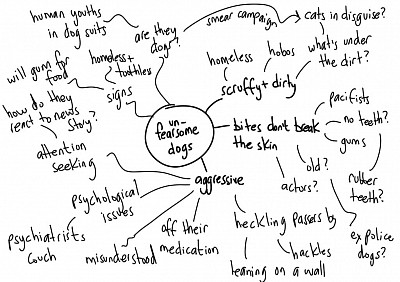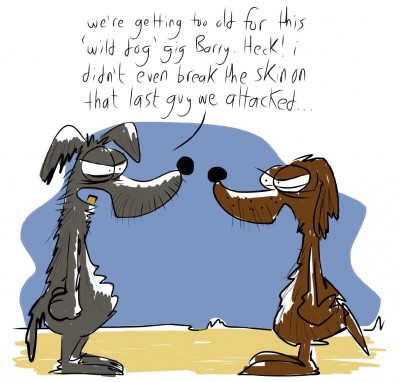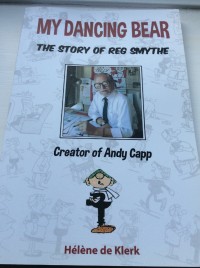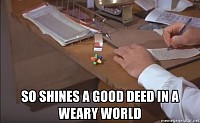Tips & Tutorials
Introduction
I am mainly self taught from books, but I have also been fortunate to have had friends who were willing to share either their artistic skills or knowledge of cartooning and the cartoon industry. I believe it is important to encourage others, and in this section of my website I will pass on what I can of what I know.
The Secrets of Cartoon Success
What is the secret of success in cartooning?
Firstly I have to admit I haven’t cracked it. If I had I would not have a day job, and I would be cartooning full time with many books to my name and some form of syndication. I don’t. So you can stop reading now (fair enough) or plough on in the vain hope I have something useful to share.
You’re still with me. Great. This is going to be surprisingly pithy and the result of decades of loving and studying cartoons and cartoonists, as well as two decades of being one. I even gave up the day job for a few years and threw myself into it lock, stock and barrel. That’s another story.
In my opinion success as a cartoonist has these elements:
1. Enough people get your humour to establish a following, which in turn leads to sales which in turn pays your bills.
2. Your drawing style delivers your humour effectively. You don’t have to be a good artist, you just have to have an appropriate style.
3. Speaking of style, it must be consistent. Your cartoons look alike and people can spot one of yours amongst a cast of hundreds. This is not a bad thing.
4. You get an opportunity. Now this is the secret recipe which could be a result of persistence and hard work, or luck, or circumstance, or someone you know or whatever. 1,2 and 3 are there and with a magical pop or ding in comes number 4. Successful cartoonist.
Why am I still doing a day job knowing this mind blowing wisdom?
1. Not enough people find me funny to tip the scales from obscure amateur to professional with a following. I know this and I accept it.
2. Sometimes my style fits the humour and sometimes it just isn’t well drawn enough or something technical is wrong or the line quality is off. I know this and I know I could improve if I put the effort in.
3. I change style like socks. I produce a cartoon in the style I feel like at that moment, and this breaks the illusion and forces any followers to readjust. I know this too but I still do it :)
4. This hasn’t happened yet. I have had a couple of my own books published, appeared in half a dozen more and sold my cartoons hundreds of times, but my moment eludes me.
Study the greats and you will see I am right.
In my opinion you have some control over 1, almost total control over 2 and 3 and as for 4...well I know of some who have grasped this and made it happen (look at Scott Adams of Dilbert fame).
If you love cartooning and you’re willing to dedicate yourself to it there are audiences out there for you! I still love it, but I don’t get as stressed about the fact I’m not a member of the Professional Cartoonists Organisation any more.
Helpful Tip - Finding the idea for a cartoon
I can't be the only artist or writer who has been asked the question:
'Where do you get your ideas from?'
And if you asked ten of us the question you would probably get ten different answers. So here is my answer, which may be of use to those of you starting out as cartoonists.
For me there are two scenarios when mining for an idea for a cartoon:
1. Sitting in front of a blank canvas with a blank mind
2. Sitting in front of a blank canvas with a subject, a theme or a brief from a client
Clearly the idea of scenario 1 is to get to scenario 2, that is, to come up with a subject to draw a cartoon about. To do this I will expose myself to input. This sounds ruder than it is, but all I mean is that you need something to work with. Personally I don't get this first step from sitting in an empty, quiet room with a wet towel wrapped around my head. I need conversations, web searches, news items, stories, scenarios, popular sayings or anything which I can absorb and then twist inside my head to take it further and make a cartoon from it.
If topical news items are your thing then pick up a newspaper or browse one of the many news summary websites for a topic that catches your interest. If you prefer observational humour then go and sit in a coffee shop and listen to the conversations around you. It is amazing how other peoples chatter, phrases or actions can sometimes inspire you. Engage people in conversation and let them talk about their day, their interests or anything they want. Sometimes the most mundane chit chat can generate some superb ideas or subjects. I wouldn't advise admitting you are a cartoonist before you engage potential muses, as it can have one of two effects; they either clam up for fear that their life is about to be the subject of a cartoon or (and this one is worse in my opinion) they start telling you all their amusing cartoon ideas in great length. Eek! These ideas are usually not great and I rarely use them!
At this stage I would also begin assessing what I am hearing and reading for potential cartoons, effectively merging all the stages into one. If you are new to this then just record ideas. Don't even try and make it funny yet. For example, here is a list of news items I have trawled from a quick scan of my local newspaper:
- Hospital to close
- Cancer survivor walks for charity
- Wind turbine schemes at risk
- Council breaches Data Protection Act
- Warning as dogs attack boy
- Market traders threaten to boycott town over parking row
This is a tiny selection obviously, but there is enough here to take us to the next stage.
Depending on your cartooning style, moral stance and sense of humour, some of these subjects may not be your cup of tea. For our purposes I am going to take the dogs article as our example. This made me laugh out loud when I read it because it is so un newsworthy to be reported at all....bear with me....I'm not callous! In the article they report that the dogs attack:
"...did not break the skin but caused a slight reddening of the area" and go on to describe these dogs as "scruffy, dirty and aggressive. "
How can any self respecting cartoonist pass that up??
So you have a subject now and a blank canvas. Often a cartoon will spring to mind for me at the moment I am processing the subject, but sometimes it proves more elusive and I need to dig a little deeper. To do this I would use what I call a spray diagram. Basically I put the idea in the middle of the paper, and then think of everything I can which is either factual, or springs to mind as I run the idea around my mind. This is the one I produced for the dogs idea.
There are lots of ideas here and you may think of many more. At first glance I can see at least six different cartoons, maybe more. This again depends on your sense of humour.
The dogs on a psychiatrists couch admitting their issues, the dogs reading the news article and their reactions, the possibilities of the dogs NOT being dogs after all and many more. I went with the dogs just being too old to continue their wild lifestyle, and this is the cartoon I would place alongside that article.
Tips from the late great Reg Smythe
I bought the biography of Reg Smythe (the creator of Andy Capp) a while back, and there was a superb little gem in there about simplification of cartoons. It applies as much to wording as it does to composition, and it is one that i should certainly be paying more attention to in my own work.
He used to apply what he called the 'fresh fish' test to each cartoon he drew. I will explain it here and then you will see the genius of the man.
The fishmonger puts a sign out that reads 'fresh fish sold here'. He then removes the word 'sold' because clearly he wants money for them and it is unnecessary. Next he removes the word 'fresh' because all his fish is fresh and he doesn't want to suggest otherwise. Now he only has 'fish here' and he removes the word 'here' because they are standing there reading the sign so they know where they are. The final sign simply reads 'Fish'.
This won't change my addiction to wordiness overnight, but it is something i will never forget. I recommend that book too, and any biography of a cartoonist you can find if that is your chosen field. There is so much to learn from these masters of their
profession.
Plagiarism, Influences and Coincidences (Oh my)
Our collection of horse gag cartoons has barely made enough over the years to buy us a couple of meals out, but such is the way of our profession. Read my post on the Secrets of Cartoon Success and it makes sense.
Before I launched into a creative binge to turn my initial ideas into a book I did some research. Norman Thelwell had the equestrian cartoon market sewn up years ago, and he is therefore an influence, but I confidently stated that there was nothing else like our idea in existence. I was wrong.
Before I talk about the coincidence I have to say that as it became clear Cartoons From The Horses Mouth wasn’t hitting the spot with our target audience, Vicky (partner and co-author) said that with hindsight we needed regular characters, humans not just horses and probably a strip format. She was right.
Check out the highly successful Fergus the Horse series by Jean Abernethy to see how right she was. This was in existence long before CFTHM sprung into my head and it had shot to fame a couple of years before. Coincidence. It is a good book and has many thousands of fans and we recently added it to our collection here.
Am I disappointed that I didn’t know about this book before I started on ours? Not at all! I wouldn’t have tried to compete, and our book now stands on its own two hooves in that market regardless. I am pleased we produced a book and whilst there are inevitable similarities CFTHM is a different product.
i didn’t mention plagiarism. Quite simply passing off something created by someone else as your own is wrong. End of.
Be influenced, indeed seek it out as inspiration. Acknowledge and accept coincidences but don’t steal.
Not Cartooning Advice
If you know your Shakespeare then you recognise that quote from Merchant of Venice, but for me and for the purposes of this statement of my opinion, it relates to the 1971 film Willy Wonka and the Chocolate Factory.
Watched it in your head or been super interested and gone to watch it? Cool, I will continue.
As a leader you need to pick those closest to you in a group or organisation very carefully. These people are the inner circle, the bridge crew, those who can do the most good and also the most harm if they betray you. In my opinion a clever leader quite rightly evaluates these individuals on a number of factors including:
The contribution they will make. What do they bring with them? Prior experience? Wealth and assets? A loyal group of followers? Prestige? Whatever this is you recognise that by letting them in and bringing them close your team, group, organisation or whatever will be better for it. Sometimes this is not immediately obvious, and it takes skill and intuition to recognise potential contribution which will only manifest after they have been picked.
Their outward personality traits. Depending on your intuition you will have assessed a number of levels of the personality these people display to the world. Unless they are extraordinarily open or you are extraordinarily insightful / psychic you won’t get all of them, so you do need to keep watching to make sure what unfolds still fits. At the basic level though they need to fit, so a leader will often select in their own image, or better, select on the basis of what is best for the group.
Their outward expressions of loyalty. Whether you take this on face value or after careful observation or test it with some sort of entrance ritual, you must be convinced to some level that the individual shares the same organisational values. They must demonstrate commitment to some but preferably all of the goals and the culture of the organisation the leader has setup.
This is what I believe a clever leader will do. How well this works depends on many factors, and the better the leader the higher the chances of getting it right first time. Wise leaders learn from their mistakes and adjust the selection criteria each time based on how well (or not) previous inner circle or bridge crew recruitments went.
So why start with the Willy Wonka meme? I will share my thoughts and draw this to a close.
In my opinion in that film Willy Wonka demonstrates the greatest way to increase the chances of picking a replacement who shares his values and is therefore a worthy addition to his inner circle. He hands out the everlasting gobstopper, which each recipient knows Wonka's competition will pay handsomely for, but will clearly damage Wonka's organisation in the process. Despite awful behaviour by Wonka, Charlie silently hands his everlasting gobstopper back as he leaves, because the organisation means more to him than his own personal needs and gain.
So each time you are about to add a person to your group who will have access to knowledge and whose actions have huge potential for harm if they go rogue on you later, apply the everlasting gobstopper test. If you don’t think they would hand it back as they leave then you shouldn’t have given it to them in the first place.




